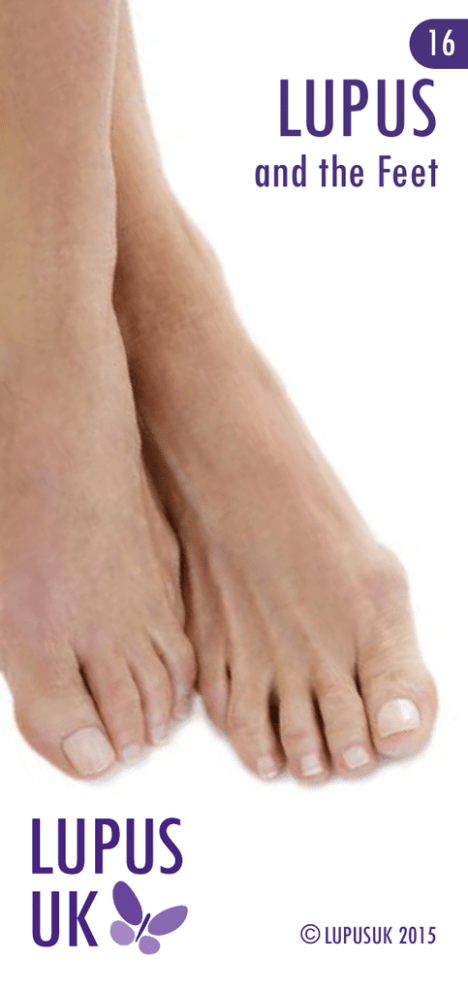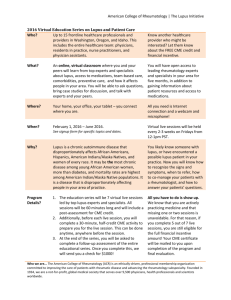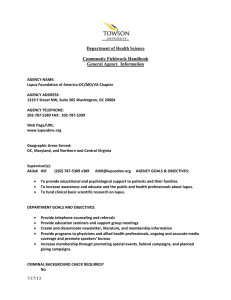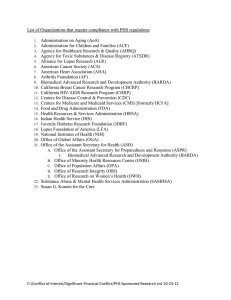and the Feet
advertisement

16 LUPUS and the Feet © LUPUSUK 2015 LUPUS and the Feet This factsheet explains about some of the foot problems associated with lupus though it is important to remember that not all will develop these problems. How does lupus affect the feet? The foot is a complex structure consisting of 26 bones, ligaments, tendons, muscles, blood vessels, nerves, skin and nails. All these work together to influence how we walk and adapt to different activities and the environment. In the general population, problems associated with these structures are common, but they can have more impact for those people with conditions such as lupus. Therefore, it is important to understand and recognise any changes to the feet and report them to your consultant, specialist nurse or podiatrist. This means that the appropriate treatment and advice are provided in order to prevent deterioration. Changes to foot structure Inflammation can affect the joints, tendons and ligaments in the feet and/or ankles causing the arch height to reduce. An indication of this is if the heels of the shoes wear out heavily or the upper of the shoe becomes distorted. People may report pain or aching associated with these changes even though there are no obvious signs of inflammation or swelling. Because it is hard to rest the feet and the body's weight is on them, these structural changes can become worse over time. This deterioration can be prevented or halted if the inflammation is reduced (through medication) and the structures of the feet are supported (with insoles and good footwear). If there are any changes to the foot structure/ toe alignment or if there is pain in the foot then the consultant or specialist nurse should be informed. Very rarely, tendons can rupture resulting in sudden and extreme loss of use of the foot/leg. If this occurs, medical help is required immediately. Changes to the blood circulation to the feet Some people can experience decreased blood supply to feet and legs associated with atherosclerosis (hardening of the arteries). This can lead to cramp-like pains in the calf, thigh or buttock muscles whilst walking. Up to 30% of people with lupus develop Raynauds phenomena. This is when the small blood vessels in the skin of the hands and feet ‘shut down’ in response to changes in temperature. Raynauds causes the toes and/or fingers to go white, then blue and then red. There may be a feeling of extreme coldness, pain/itch when the circulation returns and a tingling sensation in the affected areas. Another condition is Vasculitis, which is inflammation of the blood vessels. This can be painful with raised red patches on the legs or there may be small red or black lines around the nails. It can sometimes lead to ulcers on the feet or legs. If you have any of these signs or symptoms then seek medical advice. If the toes appear to be black, medical help is required immediately. These three conditions can reduce the amount of blood reaching the foot and toes and can cause the skin to be thin and dry. The skin may then crack (break), ulcerate and then expose the foot to infection. Serious circulatory foot and leg problems are rare but are made worse if the person smokes cigarettes. If there is redness, extreme pain and there is a break in the skin, then immediate medical attention is required, as management of an infection requires prompt intervention. Changes to the nerve supply to the feet Some people may experience problems with the nerve supply to their feet, known as Peripheral Neuropathy. This can be caused by inflammation of the small blood vessels that supply the nerves and they can become damaged, thus leading to abnormal nerve function. This means that pain and other sensations such as temperature (hot or cold) and pressure are reduced/cannot be felt. This loss of sensation can lead to damage of the skin going unnoticed and in turn, ulceration and infection. Sometimes ‘pins and needles’ may be experienced in certain parts of the feet. This may have several causes, it can be a result of changes to nerve endings or in some cases swelling compressing a nerve. These problems are less common but if they occur, the consultant or specialist nurse should be informed. Skin and nail problems People with lupus can also develop common foot problems such as corns, hard skin and thickened or ingrowing toenails. Lupus is an autoimmune condition and some of the medications affect the body’s resistance to infection such as bacterial, viral (verruca) and fungal (athletes foot and fungal nails) infections. During medical consultations, these problems may be overlooked as there are usually other priorities to discuss. However, it is important to tell your consultant or specialist nurse about these problems. Shape changes in the front of the foot and the toes can create pressure sites that develop corns and calluses (hard skin). If not treated appropriately, these may develop into areas of ulceration, and so it is advisable to request guidance from an HCPC registered podiatrist. Some medications can also have an effect on the skin and underlying tissues, making them more vulnerable to damage and infection. It is important that anyone treating foot problems is aware of all the medications so that they can manage any potential problems appropriately. Athlete’s foot is a fungal infection characterised by itchiness and sometimes white and ‘wet’ skin between the toes or flaky redness on other areas. The fungus also breaks down the skins natural barrier to bacterial infections and these in turn can be severe. Athlete’s foot can be treated with medications - spray, powder, cream but it is better to get an accurate diagnosis first. Sometimes nails can become thick due to pressure or it may be caused by a fungal infection in the nail (often yellow or brown and flaky). Alternatively nails can also become excessively curved and need to be managed by a podiatrist. Difficulty cutting these curved nails can lead to a spike of nail becoming embedded in the side of the toe (termed an ingrowing toe nail) this may become infected with extreme pain being the main symptom with redness and sometimes pus. If you think you may have an ingrowing toe nail or if there is a break in the skin, then medical help is required immediately. How can I help myself? Generally, lupus does not cause major foot problems but it is good to develop a routine for looking after them. Nails must be cut carefully, although it is often easier and safer to file them rather than cut them, particularly if they are thick or uneven. The feet should be washed and examined daily for any damage or problems. Any dry skin should be kept moist with a good moisturising cream to prevent cracks from occurring. Professional guidance should always be sought about self-treatment of hard skin and corns – DO NOT use pedicure blades, corn plasters and paints on these areas. It is vital to wear well-fitting footwear that does not constrict the circulation but is supportive enough for the structures of the feet. Ideally, shoes should have a thick, soft cushioned sole, a pliable yielding upper and fasten firmly around the instep, preferably with laces and a low heel. There should be no high-pressure areas on the feet which rub the skin but plenty of support around the sides of the heel. Soft slippers are not helpful as they provide very little support. If there are circulatory problems, then the feet must be kept warm. Two thin pairs of socks are warmer than one thick pair and in cold weather thermal insoles should be put in shoes and bed socks worn at night. Keeping your body at a constant temperature is helpful. By wearing good thermal clothing you will keep the body’s core temperature up when the weather is cold or changeable. If your feet are cold then try to warm them up gradually and avoid direct heat from radiators, fires or hot water as you may damage your skin without realising it. It is better to gradually warm the area over a longer period of time. Who can help with these foot problems? Podiatrists can assess your foot structure and the blood and nerve supply. They provide care for common foot problems, advice on footwear and provide insoles (orthoses) in order to relieve foot pain and improve the alignment of joints. They can also provide management of infections and acute foot problems such as ingrowing toe nails (they carry out minor nail surgery also). Podiatrists who work for the NHS are required to register with the Health and Care Professions Council (HCPC) in order to practice. If you see a podiatrist privately, you can check registration online (http://www.hpcuk.org/landing/?id=4). Availability of NHS podiatrists does vary in different areas but people with lupus should be able to have NHS podiatry regardless of age. If you are unsure then ask your consultant or specialist nurse. The LUPUS UK Range of Factsheets A range of factsheets are available as follows: 1. LUPUS Incidence within the Community 2. LUPUS A Guide for Patients 3. LUPUS The Symptoms and Diagnosis 4. LUPUS The Joints and Muscles 5. LUPUS The Skin and Hair 6. LUPUS Fatigue and your Lifestyle 7. LUPUS and Pregnancy 8. LUPUS and Blood Disorders 9. LUPUS and Medication 10. LUPUS and the Kidneys 11. LUPUS and Associated Conditions 12. LUPUS and the Brain 13. LUPUS The Heart and Lungs 14. LUPUS The Mouth, Nose and Eyes 15. LUPUS and Light Sensitivity 16. LUPUS and the Feet 17. LUPUS and Men 18. LUPUS and Mixed Connective Tissue Disease LUPUS UK is the registered national charity caring for people with lupus and has over 5,500 members who are supported by the Regional Groups. LUPUS UK acknowledges with gratitude the assistance of Dr Anita Williams PhD, BSc (hons) FCPodM, FFPM FCPS (Glasg), Senior Lecturer Post Graduate Research Student Co-ordinator, University of Salford, Manchester, in the provision of information towards the production of this factsheet. LUPUS UK also thanks the Wooler Walkers (Northumberland) for their valued sponsorship towards the cost of producing the factsheets. Please contact our National Office should you require further information about the sources used in the production of this factsheet or for further information about lupus. LUPUS UK will be pleased to provide a booklist and details of membership. LUPUS UK is certified under the requirements of the Information Standard. St James House, Eastern Road, Romford, Essex RM1 3NH Tel: 01708 731251 www.lupusuk.org.uk Reg. Charity nos. 1051610, SC039682 Last reviewed April 2015 - Next review due April 2018 5k RW 9/15




